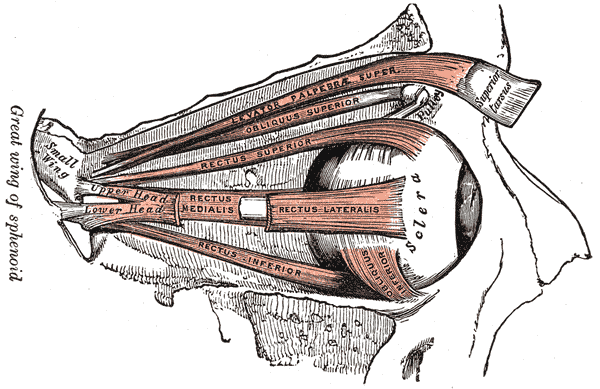- Phantom eye syndrome
Infobox_Disease
Name = Phantom eye syndrome

Caption = Anatomy of theeye . The external eye muscles are shown in red.
DiseasesDB =
ICD10 = ICD10|G|54|6|g|50, ICD10|G|54|7|g|50
ICD9 = ICD9|353.6
ICDO =
OMIM =
MedlinePlus =
eMedicineSubj =
eMedicineTopic =The phantom eye syndrome is a
phantom pain in the eye and visualhallucinations , after the removal of an eye (enucleation ,evisceration ).Symptomatology
Many patients experience one or more phantom phenomena after the removal of the eye:
*Phantom pain in the (removed) eye (prevalence: 26%)cite journal |first=P. |last=Sörös |coauthors=O. Vo, I.-W. Husstedt, S. Evers and H. Gerding |title=Phantom eye syndrome: Its prevalence, phenomenology, and putative mechanisms |journal=Neurology |volume=60 |issue=9 |pages=1542–3 |year=2003 |month=May |pmid=12743251 |doi= |url=http://www.neurology.org/cgi/pmidlookup?view=long&pmid=12743251 |accessdate=2008-09-23]
*Non-painful phantom sensations
*Visualhallucinations . About 30% of patients report visual hallucinations of the removed eye. Most of these hallucinations consist of basic perceptions (shapes, colors). In contrast, visual hallucinations caused by severe visual loss (Charles Bonnet syndrome ) are less frequent (prevalence 10%) and often consist of detailed images.Pathogenesis
Phantom pain and non-painful phantom sensations
Phantom pain and non-painful phantom sensations result from changes in the central nervous system due to denervation of a body part.cite journal |first=Vilayanur S. |last=Ramachandran |authorlink=Vilayanur S. Ramachandran |coauthors=W Hirstein |title=The perception of phantom limbs. The D. O. Hebb lecture |journal=Brain |volume=121 |issue=9 |pages=1603–30 |year=1998 |month=September |pmid=9762952 |doi= |url=http://brain.oxfordjournals.org/cgi/pmidlookup?view=long&pmid=9762952 |accessdate=2008-09-23] cite journal |first=L. |last=Nikolajsen |coauthors=T. S. Jensen |title=Phantom limb pain |journal=
British Journal of Anaesthesia |volume=87 |issue=1 |pages=107–16 |year=2001 |month=July |pmid=11460799 |doi= |url=http://bja.oxfordjournals.org/cgi/pmidlookup?view=long&pmid=11460799 |accessdate=2008-09-23] Phantom eye pain is considerably less common than phantom limb pain. The prevalence of phantom pain after limbamputation ranged from 50% to 78%. The prevalence of phantom eye pain, in contrast, is about 30%.Post-amputation changes in the cortical representation of body parts adjacent to the amputated limb are believed to contribute to the development of phantom pain and nonpainful phantom sensations. One reason for the smaller number of patients with phantom eye pain compared with those with phantom limb pain may be the smaller cortical
somatosensory representation of the eye compared with the limbs.In limb amputees, somecite journal |author=Nikolajsen L, Ilkjaer S, Krøner K, Christensen JH, Jensen TS |title=The influence of preamputation pain on postamputation stump and phantom pain |journal=Pain |volume=72 |issue=3 |pages=393–405 |year=1997 |month=September |pmid=9313280 |doi= |url=http://linkinghub.elsevier.com/retrieve/pii/S0304395997000614 |accessdate=2008-09-23] but not all studies have found a correlation between preoperative pain in the affected limb and postoperative phantom pain. There is a significant association between painful and nonpainful phantom experiences and preoperative pain in the symptomatic eye and
headache .cite journal |first=M. |last=Nicolodi |coauthors=R. Frezzotti, A. Diadori, A. Nuti and F. Sicuteri |title=Phantom eye: features and prevalence. The predisposing role of headache |journal=Cephalalgia |volume=17 |issue=4 |pages=501–4 |year=1997 |month=June |pmid=9209770 |doi= |url=http://www.blackwell-synergy.com/openurl?genre=article&sid=nlm:pubmed&issn=0333-1024&date=1997&volume=17&issue=4&spage=501 |accessdate=2008-09-23] Based on the present data it is difficult to determine if headaches or preoperative eye pain play a causal role in the development of phantom phenomena, or if headache, preoperative eye pain, and postoperative phantom eye experiences are only epiphenomena of an underlying factor. However, a study in humans demonstrated that experimental pain leads to a rapid reorganization of thesomatosensory cortex .cite journal |first=Peter |last=Sörös |coauthors=Stefan Knechta, Carsten Bantelb, Tanya Imaia, Rainer Wüstenb, Christo Pantevc, Bernd Lütkenhönerc, Hartmut Bürkleb and Henning Henningsen |title=Functional reorganization of the human primary somatosensory cortex after acute pain demonstrated by magnetoencephalography |journal=Neuroscience Letters |volume=298 |issue=3 |pages=195–8 |year=2001 |month=February |pmid=11165440 |doi= |url=http://linkinghub.elsevier.com/retrieve/pii/S0304394000017523 |accessdate=2008-09-23] This study suggests that preoperative and postoperative pain may be an important cofactor for somatosensory reorganization and the development of phantom experiences.Visual hallucinations
Enucleation of an eye and, similarly, retinal damage, lead to a cascade of events in the cortical areas receiving visual input. Cortical
GABA ergic (GABA: Gamma-aminobutyric acid) inhibition decreases and corticalglutamate rgic excitation increases, followed by increased visual excitibility or even spontaneous activity in thevisual cortex .cite journal |first=Ulf T. |last=Eysel |coauthors=Georg Schweigart, Thomas Mittmann, Dirk Eyding, Ying Qu, Frans Vandesande, Guy Orban and Lutgarde Arckens |title=Reorganization in the visual cortex after retinal and cortical damage |journal=Restorative Neurology and Neuroscience |volume=15 |issue=2-3 |pages=153–64 |year=1999 |pmid=12671230 |doi= |url=http://iospress.metapress.com/openurl.asp?genre=article&issn=0922-6028&volume=15&issue=2&spage=153 |accessdate=2008-09-23] It is believed that spontaneous activity in the denervated visual cortex is the neural correlate of visual hallucinations.References
See also
*
Visual system
*Charles Bonnet syndrome External links
*cite web |url=http://www.wellcome.ac.uk/en/pain/microsite/medicine2.html |title=Phantom limb pain |accessdate=2008-09-23 |publisher=
Wellcome Trust |first=Jonathan |last=Cole
*http://psy.ucsd.edu/chip/ramabio.html Dead link|date=September 2008 Homepage ofVilayanur S. Ramachandran
Wikimedia Foundation. 2010.
